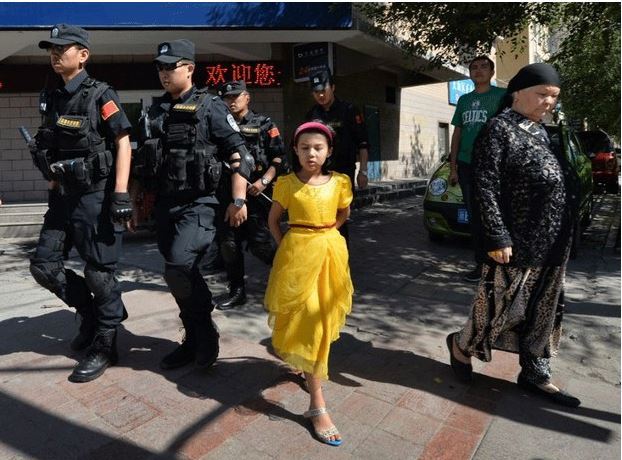
Chinese Policy Toward Xinjiang Resembles Soviet Policies Toward Central Asia, Highlights Differences Between West and East ‘Turkestan’
Publication: Eurasia Daily Monitor Volume: 10 Issue: 165
By:

On August 20, Chinese authorities shot dead at least 16 ethnic Uighurs in a desert area of the Xinjiang-Uighur Autonomous Region (XUAR), accusing them of terrorism and illegal religious activity. They were among a group of more than 20 Uighurs surrounded and fired upon by police in a lightning raid last week in the Yilkiqi township in Kargilik (in Chinese, Yecheng) county, in the Kashgar prefecture of the XUAR (South China Morning Post, August 29).
The Yilkiqi incident follows a spate of violence across Xinjiang in recent months that led to a crackdown, with hundreds of Uighurs detained for questioning by the authorities. In early August, police opened fire on a crowd of Uighurs protesting prayer restrictions in a city of Akyol in the Aksu prefecture ahead of the festival marking the end of Islam’s holy month of Ramadan, killing at least three and injuring about 50 others. In June, up to 46 people were killed in Lukchun Township of Pichan County in the Turpan prefecture after police opened fire on “knife-wielding mobs” that had attacked police stations and other sites in the county. This was the bloodiest violence since the July 5, 2009 unrest in Xinjiang’s regional capital of Urumqi that had triggered a massive crackdown. Also in June, in the Hotan prefecture’s Hanerik township, police fired on hundreds of Uighurs protesting against the arrest of a young religious leader and the closure of a mosque. According to officials, up to 15 people may have been killed and 50 others injured (Radio Free Asia, August 26).
The Xinjiang-Uighur Autonomous Region (also commonly referred to as East Turkestan) and Central Asia make up one ethnic-cultural region, historically called Turkestan. But while Central Asia was colonized by Russians, East Turkestan was colonized by the Chinese. According to the last Chinese national census (2010), the current population of XUAR is 21.8 million, of which Han Chinese make up 8.7 million, or 40.1 percent. The rest, approximately 13 million, are minorities, mainly Uighurs and smaller numbers of other Turkic groups such as Kazakhs, Tajiks and Uzbeks (https://www.stats.gov.cn/tjgb/rkpcgb/dfrkpcgb/t20120228_402804343.htm). Since the incorporation of East Turkestan into China, Uighurs have staged over 400 rebellions against the central government (Igor Rotar, “Under the Green Banner: Islamic Radicals in Russia and the Former Soviet Union,” Religion, State & Society 30(2), June 2002).
In some sense, Beijing is emulating the Soviet policy toward these ethnic minorities. There are Uighur, Kazakh and Tajik autonomous districts in Xinjiang, just as nationalities like the Kazakhs, Kyrgyz, Tatars and Uzbeks had their own titular Soviet Socialist Republics or Autonomous Soviet Socialist Republics within the Soviet Union. All XUAR autonomies have their own TV channels and newspapers in the local languages. However, current tensions between Uighurs and Han Chinese in Xinjiang are much stronger than that between Russians and Central Asian peoples during the Soviet period. Most Uighurs do not speak Chinese and do not even try to study the language. A de-facto system of segregation has become established in Xinjiang: Uighurs and Han Chinese live in different town districts and rarely communicate with each other (Igor Rotar, “Under the Green Banner: Islamic Radicals in Russia and the Former Soviet Union,” Religion, State & Society 30(2), June 2002).
On the other hand, anti-Russian sentiments were not typical in Central Asia under the Soviet period and are not typical nowadays. Most people in Soviet-era Central Asia fluently spoke Russian. And since a great number of Central Asians today work in Russia as guest workers, the Russian language maintains its popularity and prestige within the Central Asian republics (Igor Rotar, “Under the Green Banner: Islamic Radicals in Russia and the Former Soviet Union,” Religion, State & Society 30(2), June 2002).
The difference between the levels of tension and conflict between the “colonizers and indigenous people” in Central Asia as compared to Xinjiang may be explained by two factors. First, Uighurs are, on average, more religious than the Central Asian nationalities. Second, from the standpoint of Islam, the people of the “holy book” (Christians and Jews) are much “better” regarded than followers of other religions. Thus, many devout Uighur Muslims believe that, in accordance with Islam, they should not accept a life under Chinese rule, because “the Chinese are heathens.” For example, Uighurs avoid going into Chinese restaurants since meals there are not cooked in accordance with Muslim requirements. By comparison, in Central Asia, when it was a part of the Soviet Union, such arguments were not heard among devout Muslims, who had no qualms about entering Russian establishments (Forum-18, August 15, 2006).
The Chinese government presumes—with some justification—that Uighur religiosity is linked with an advocacy for a separate Uighur state. Therefore, Chinese authorities try to control all aspects of religious life in XUAR. Illustratively, Xinjiang’s imams are obliged to go to their local state Religious Affairs Bureau to discuss the text of their weekly Friday sermons with officials. And during the Islamic fasting month of Ramadan, authorities force Muslim schoolchildren to eat lunch. State employees are under similar pressure (Forum-18, August 15, 2006).
Yet, in addition to actively repressing religious freedom and separatist tendencies, at the same time, Beijing has been dramatically developing the industry and the social structure of Xinjiang. The changes have been enormous. For example, as this writer has witnessed, at the beginning of the 1990s, the main modes of transport in XUAR were via horse-drawn vehicles and bicycles. While nowadays, Xinjiang’s towns resemble some of the most developed cities in the world.
“The huge monetary investment in the Xinjiang-Uighur Region, together with the cruel suppression of separatist tendencies, weakens the options for Uighur independence supporters. One should also keep in mind that [Han] Chinese already constitute 40 percent of [Xinjiang’s] population, and the migration of Chinese to the region, which is backed by Beijing, is continuing. Apparently, some local revolts will periodically break out in Xinjiang [to be immediately suppressed by the authorities], but a large-scale lengthy rebellion is hardly possible,” Adjar Kurtov, the leading China scholar of the Russian Institute of Strategic Research, told Jamestown on September 8.
China’s “carrot-and-stick” policy is, therefore, bringing about certain results. This writer visits the XUAR regularly since the beginning of the 1990s and over time has observed the number of Uighur independence supporters steadily decreasing. Although Uighurs still have no special affinity toward the Han Chinese, nevertheless, the possibility to run their businesses unhindered, coupled with the fear of arrest for advocating separatism, turn out to be stronger incentives than abstract ideals of freedom. Yet, the question still remains: as Chinese political control over Xinjiang continues to intensify, will the Uighurs’ cultural ties to the rest of Central Asia simultaneously wither away?




